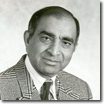
 |
By Michael F. Carmichael
February 5, 2009
In the mid-1990s Dearborn proctologist Dr. Max Ali discovered he was diabetic as the result of a near-heart attack. That caused him to lose his flying instructor’s license - he had, in addition to his medical practice, a flight school with two aircraft - but not his love for dancing.
“I always had an inborn desire to dance,” Ali says, “but in India there were very few opportunities to do so. I actually learned how to dance from someone in my dorm in med school. It was an all male dorm, with no women allowed, so we danced with pillows as partners. It was when the Beatles were hot so we learned the fox trot and the waltz - and how to dance to Hard Day’s Night.”
When he received his M.D., Ali came to the United States to practice. “When I got here I figured, ‘I have to dance'” he says. “So I took lessons. But I’m the kind of person who, after he learns something, has to teach it to others. It’s my way of strengthening my learning. It was that way with surgery, and flying, and it was that way with dancing. I became a certified dance teacher. I’ve written articles about dance. I’ve contributed to blogs about dance.
 |
After years of working in a full-service hospital, Dr. Ali opened a specialty clinic, Hemorrhoid Clinic of America, in Oak Park that has a complete surgical suite. He still, however, has time for teaching others to dance. “I spend two or three days a week teaching dancing,” he explains. “And to those who say they have two left feet, I tell them that is the biggest myth. Anybody who can walk can dance.”
With dancing making a comeback, thanks to shows like “Dancing With The Stars,” Ali stresses there is more to dancing than people normally consider. “What people aren’t thinking about, though,” he says, “is dancing for your health. When you compare a half-hour workout to a half-hour dancing you are sweating more with dancing. Really. With a good partner and good competition, that’s dancing - not the slow dance way.” Asked about his preference in dance styles, Ali says he “prefers ballroom and Latin dancing. But not salsa. That’s not dancing, it’s more into drinking and misbehaving, not dancing.”
He bemoans the decreasing number of places where you can go to have a good dinner and dance graciously to the music of Benny Goodman and Frank Sinatra. “Even disco is gone,” he complains. “All we have now for the most part is salsa clubs.”
What about the kind of competitive dancing on Dancing With The Stars? “Competition? I’ve done a lot of competitive dancing. I competed as a student, and I’ll take an occasional student to a competition. There is a competition coming up in March that I’m taking one of my students to,” he says. “But I do less of that now. The travel and all was getting to be too much of a burden. You can spend thousands of dollars, you rush for airplanes, it’s just not my style any more.”
When you take a look at the results for a Google search for “dancesport” (following Dr. Ali’s suggestion) you realize how big the competitive world of dancing can be. Shoes in the hundreds of dollars, costumes for more than that, even fake tans for upwards of $50 - it all adds up.
What does a novice dancer do to learn more about dance? “Watch a good DVD,” suggests Ali. “A good source is Dance Vision in California, for very beginners to advanced. Of course,” he laughs, “they’re a lot more expensive now than 20 years ago when you could pick up a videocassette.”
What would he do to broaden the appeal of dancing, particularly today? Ali replies, “I just wish hospitals would set up little dance clubs where the doctors and other staff members could go after work and dance for an hour. It’s great exercise and great therapy. Remember, I’m a doctor and I know how good dancing can be for you. Even health clubs and gyms could do that for other high-stress-level executives. They’d be amazed at how good they can feel after dancing an hour.” Better yet, Ali suggests, start people off on the right foot when they’re young. “Schools should make dance a part of the high school curriculum. It’s such an important part of life.”
ONE-two-three. ONE-two-three.








